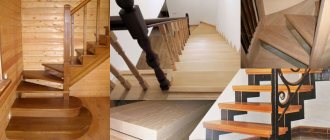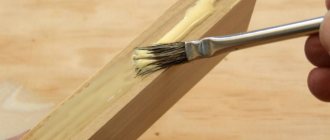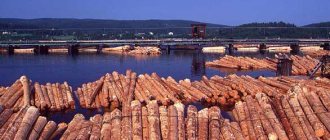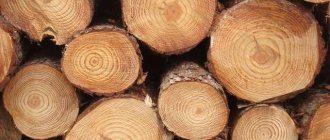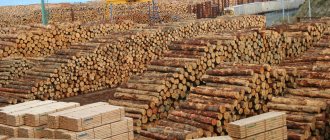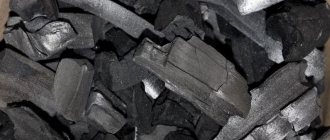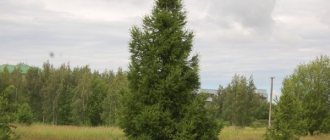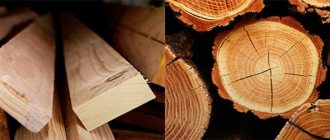What is wood density
The unit of wood density is gm/cm3 or kg/m3 (in the SI system). This indicator is determined by the formula: p = mb/Vb. The symbol m denotes the mass of the material, b is the moisture parameter, Vb is the volume of the wet substance. The following types of wood densities are distinguished:
- Specific gravity (conditional or basic density): characterizes the ratio of the mass of dry wood substance to its volume.
- Volumetric weight (average density): determines the ratio of the mass of a structured physical body in a wet state to its volume.
Wood contains a large number of intercellular spaces called voids. Wood substance is obtained by pressing wood. As a result, the voids completely disappear. The density of compressed wood is less than the specific gravity of the wood substance. The higher the value of this indicator, the stronger the material. Wood with a high specific gravity is more difficult to process and is not impregnated with antiseptics.
Density measurement is carried out according to the following algorithm:
- Maintain the measured sample to a moisture content of at least 11%.
- Calculation of dimensional characteristics and weight of a wooden workpiece.
- Based on the measurements taken, the volume of wood is calculated. The workpiece is moistened in distilled water for 3 days until its thickness increases by 0.1 mm.
- The size and weight of the dampened wood are re-measured. Based on the new data, the maximum volume is calculated.
- The workpiece is dried and re-weighed. The mass of the dry sample is divided by the maximum volume. The result of the calculations will be the basis density.
- The mass of the dry workpiece is measured again. Based on these values, the specific gravity of wood is calculated.
The algorithm for calculating this indicator is specified in GOST 16483.1-84. It is recommended to carry out measurements on blanks in the shape of a rectangular lens. The length of the base of the sample being measured should be 20 mm, width – 20 mm, height – 30 mm. The edges of the workpiece must be carefully processed before measuring the density of the wood.
GOST 16483.1-84 Wood. Density determination method
1 file 197.93 KB
In most European countries, instead of wood density, the growth rate is used. It characterizes the average thickness of the growth layers. This parameter is used when calculating the amount of change in the volume of a tree over a certain period of time. The main advantage of the growth parameter is the ease of calculation, which will reduce the cost of mathematical measurements. According to professional experts, this parameter does not characterize the physical properties of wood. Therefore, it is not related to the density of the substance. In the Russian Federation, the growth rate is used by centers for the examination and standardization of timber.
What is cedar and where is cedar wood used?
Cedar is an evergreen coniferous pine tree. Cedar is a demanding tree and prefers to grow only in environmentally friendly and mostly warm places. However, it tolerates cold climates quite well, which is why cedar has taken root in Siberian forests, which do not have a warm climate. It practically does not take root in polluted regions. This is one of the most ancient trees in the World.
cedar forest
Cedar grows slowly; there are cedars whose age reaches 800 years. In diameter, the tree trunk can reach from 2 to 7 meters. This is the second largest tree in the world, after the American sequoia.
Cedar habitats can be classified as a slowly but endangered tree species. Currently, only 8 species of this tree remain. The reason for this is not only human activity, but also various natural processes. Cedars are grown in the territories of the South Caucasus, the Crimean Peninsula, some regions of the Black Sea, Central Asia, and were introduced and grown in some European countries. There are a lot of solitary cedars growing in the most unexpected places. Cedar can grow either in a cedar grove or alone in mixed habitats of trees. In addition to Siberian forests, cedar is found in the Moscow region, Leningrad region, Altai, Urals, Voronezh region of the Russian Federation.
In the old days, cedar was used to make dishes and containers for storing food. Such products lasted longer and, according to the beliefs of the taiga peoples, had a special taste and strength. Log houses made of cedar are a natural antiseptic and have a healing effect. Cedar wood is used in pencil production, making food containers, for flooring, furniture making, and interior decoration.
Relationship with other parameters
Wood density is related to the following physical properties of wood:
- Porosity: The structure of wooden blocks has a heterogeneous structure and consists of a large number of pores. The more empty spaces there are in a wooden piece, the lower the density of its material.
- Weight: the greater the weight of the block, the greater its mass. This indicator is directly related to the density of the substance. The heavier the lumber, the denser it is.
- Humidity: The more liquid a block of wood contains, the higher the ratio of the material's mass to its volume. This indicator depends on the ambient temperature and automatically decreases when the wood dries. When moisture evaporates, mechanical deformation of the wooden workpiece is possible.
- Absorption: This property characterizes the ability of wood to absorb moisture. The higher the absorbency of the material, the higher its density. If wood absorbs a large amount of liquid, then a small number of pores will be present on the surface of the block. The degree of absorption is higher on the cross section of the bar, where the main pores are not closed.
- Thermal conductivity: characterizes the ability of a substance to conduct thermal energy. Materials with low density conduct heat at a lower intensity. This is due to the large number of pores filled with oxygen. They insulate the surface of the wood from heat. As a result, the material heats up over a long period of time. For this reason, in rooms where heat treatment of materials is carried out, lumber with high strength is used.
- Flammability: the lower the mass-to-volume ratio of wood, the faster it ignites. This is due to the large number of pores filled with liquid. Soft woods burn the most intensely.
- Strength: at low density, the material becomes resistant to physical deformation. Strong bars quickly split and change their shape when colliding with foreign objects.
- Biological factors: lumber with a high material density does not rot. This is due to the large number of pores that absorb moisture. By keeping the material in distilled water, its resistance to biological factors can be improved.
One of the main properties associated with density is the hardness of wood. It characterizes the ability of a tree to withstand heavy loads. The greater the volumetric weight of a wooden block, the greater its hardness. Soft rocks have high thermal conductivity and are not subject to mechanical deformation. Solid wood ignites with less intensity.
Hardness is determined by the Brinell test. To carry out calculations, a metal ball with a diameter of 1 mm is required. It is pressed into the surface of the wooden workpiece. The hole made is measured using rulers and calipers. The depth of the hole being measured is the Brinell coefficient, which is used to evaluate the hardness of a material.
When independently determining the Brinell coefficient, errors may occur, which will lead to inaccurate measurements.
Therefore, to assess the stability of a material, a table of hardness of different types of wood is used: Brinell coefficient of wood types
| Type of wood | Brinell coefficient | Features of the material and scope |
| Acacia | 7.1 kgf/mm² | Grows in North America. Used for making parquet and furniture. |
| Beech | 3.8 kgf/mm² | Grows in Europe, Western Asia, North and South America. Beech has a soft texture and is easy to process with cutting tools. |
| Bamboo | 4.7 kgf/mm² | Grows in Southeast Asia. Resistant to high temperature changes, effectively absorbs moisture. Used in medicine. |
| Birch | 3.3 kgf/mm² | Grows in Europe. Has low resistance to high temperatures. Used in the production of decorative elements. |
| Cherry | 3.6 kgf/mm² | Grows in Europe, Asia and North America. It has an even-fiber structure and is easy to process. |
| Hornbeam | 3.5 kgf/mm² | Grows in the south of Russia. It has twisted fibers and high strength. |
| Oak | 3.8 kgf/mm² | Grows in Europe and North America. Resistant to mechanical deformation and has a long service life. Used in the manufacture of plank floors. |
| Spruce | 1.3 kgf/mm² | Grows in Europe and North America. It is characterized by heterogeneity of color and low degree of absorption. Used in the construction sector. |
| Maple | 4.8 kgf/mm² | Grows in North America and Europe. Prone to cracking. Used in the manufacture of furniture. |
| Walnut | 5 kgf/mm² | Grows in Southern Europe, Central Asia and the Middle East. It is characterized by high humidity and structural strength. Used in medicine. |
| Alder | 3.0 kgf/mm² | Grows in Western Asia. Europe and North Africa. It has a fine structure and can be deformed. Used in the production of parquet. |
| Pine | 1.6 kgf/mm² | Grows in Europe, North America and Asia. It has low thermal conductivity and is non-flammable. For this reason, this material is actively used in the construction of rooms where heat treatment is carried out. |
| Ash | 4.1 kgf/mm² | Grows in Europe. Elastic, easy to machine. Used to make sports equipment. |
The hardness table is used in industrial enterprises. It allows workers to choose the optimal materials for carrying out physical and mathematical measurements.
Humidity dependent
The moisture content of wood is one of the main parameters affecting the density of this material. If there is a large amount of moisture, the weight of the bar increases. As a result, the mass of the workpiece increases. Therefore, the density of wood where there is no moisture is lower. Wet samples have high strength and hardness.
There are 3 main categories of wood based on moisture content:
- Absolutely dry: humidity value is less than 25%.
- Air-dry (semi-dry): humidity ranges from 25 to 35%.
- Damp: humidity value is over 35%.
The moisture content of freshly cut wood is at least 50%. Therefore, the raw materials are subjected to natural drying under a canopy. This procedure allows you to reduce the amount of moisture by up to 25%. To further reduce this indicator, it is necessary to place the wood in drying chambers. The measurement can be carried out at a humidity of no more than 12%.
Hardness measurement
To determine hardness, 3 main methods are used:
- According to the Brinell coefficient: a ball of metallic materials is driven into the surface of a log or bar. The diameter of the inserted object is no more than 1 cm. The degree of load on the ball is determined by the following formula: F = K × D2. K is the ratio of the mass of the material to its volume, D is the diameter of the ball. The depth of the resulting hole is measured. To determine hardness, you need to divide the length of the formed hole and the degree of load on the ball.
- According to the Janka scale: a steel ball with a diameter of 11.3 cm is driven into the surface of a log or block. After this, the force with which the object was pressed into the surface of the wood is calculated. It is important that the ball penetrates 50% of its diameter into the workpiece.
- According to the Rockwell scale: an indenter, which is a diamond cone, is driven into the surface of the wood. The depth of the hole made is measured. The obtained result is compared with the table values. Hardness is assessed using the HR unit of 0.0002 mm.
The main methods for calculating the hardness index are described in GOST 16483.17-81. In reference materials, the value of this indicator is indicated as 1 kgf/mm2 = 9.81 N/mm2.
GOST 16483.17-81 Wood. Method for determining static hardness
1 file 138.94 KB
Why do different types of wood have different densities?
This is the will of nature. Trees grow in both hot deserts and cool swamps, and try to survive in any conditions. In the middle zone, where it is only difficult in winter or in windy weather, plants have access to an abundance of nutrients in moist, moderately warm and well-fertilized soil. The tree, without denying itself anything, is saturated through the roots, the cambium grows quickly, and the fibers are filled with moisture. After drying, such wood loses a lot in weight and, accordingly, in density.
Plants in difficult climatic conditions have to accumulate vital substances inside the fibers. They learn to produce oils that protect them from drought and insects. Constant shortage and stress makes trees not only thrifty, but also slow growing. The minimal growth of cambium throughout the year makes the growth rings practically indistinguishable, and the lack of moisture leads to the appearance of oils in the fibers, which do not evaporate after drying.
The oiliness of some rocks can be felt with your fingers, and sometimes visually - for example, if you treat the surface of the bar with a solvent:
Different types of wood originated and took root where they were able to adapt to the conditions, and grow in close relationship with the surrounding flora and fauna. Trees detect any changes in the environment, responding to them with adaptation in the structure itself, so even within a breed, family, genus and species, plants can differ greatly from each other. Including density.
These rocks grow on the same continent in similar weather conditions, but under a microscope their structure is very different:
Classification of tree species by density
The following types of wood are distinguished according to density:
- Rocks with low density: from 1 to 540 kg/m3.
- Rocks with average density: from 541 to 740 kg/m3.
- Rocks with high density: from 750 kg/m3.
The largest number of trees with dense wood grows in Europe, North and South America. Backout has the highest density (up to 1300 kg/m3). The densest wood species are indicated in the State Reference Data System, controlled by the State Standard of the Russian Federation.
Table of densities of different types of wood
For those who like numbers and comparisons, we have made a table with the density indicators of the breeds that we have in our assortment. For clarity, the squeaks are sorted from largest to smallest - from wood, comparable in weight to stone, to that from which weightless floats are made.
All indicators are intentionally averaged and do not guarantee that the bar you purchased corresponds to them. After all, as we have already said, wood is a living and heterogeneous material that does not fit into strict frameworks and characteristics.
Table values of wood density
The following table shows the density of different types of wood:
| Wood density table | |
| Tree name | Density kg/m3 |
| Acacia | 830 |
| Bamboo | 870 |
| Birch | 540-700 |
| Beech | 650-700 |
| American cherry | 490-670 |
| Elm | 670-710 |
| Hornbeam | 500-820 |
| Oak | 600-930 |
| Spruce | 400-500 |
| Cedar | 580-770 |
| Linden | 320-560 |
| Larch | 950-1020 |
| Alder | 380-640 |
| Walnut | 500-650 |
| Pine | 400-500 |
| Eucalyptus | 690-1110 |
| Ash | 660-700 |
| Balsa (Balsa) | 120-160 |
| Siberian fir | 390-430 |
| Sequoia | 410 |
| Poplar | 400-500 |
| Willow | 460 |
| Pine | 450-500 |
| Red tree | 540 |
| horse chestnut | 560 |
| Edible chestnut | 590 |
| Cypress | 600 |
| Bird cherry | 610 |
| Sapelli | 620 |
| Hazel | 630 |
| Field maple | 670 |
| Teak | 670 |
| Pear | 690 |
| Afromosia | 700 |
| Switenia (mahogany) | 700 |
| Sycamore | 700 |
| Zhoster (buckthorn) | 710 |
| Paduc | 750 |
| Tiss | 750 |
| Dussia | 800 |
| Kempas | 800 |
| Plum | 800 |
| Lilac | 800 |
| Hawthorn | 800 |
| Rosewood | 800-1000 |
| Pecan (cariah) | 830 |
| Yarra | 830 |
| Merbau | 840 |
| Jatoba (mareil) | 840 |
| Keruing | 850 |
| Kulahi | 850 |
| Turmoil | 850 |
| Wenge | 900 |
| Lapacho | 900 |
| Olive | 900 |
| Sandalwood | 900 |
| Panga-panga | 950 |
| Boxwood | 960 |
| Lim | 970 |
| Sucupira | 1 000 |
| Kumara | 1 100 |
| Ebony (Persimmon) | 1 080 |
| Ebony | 1 160 |
| Quebracho | 1 210 |
| Guaiacum or bakout | 1 280 |
Coniferous trees have the lowest density. The highest mass-to-volume ratio is observed in hard deciduous and tropical trees. This is due to climatic conditions. Coniferous trees grow in forest areas and tundras where there is a lack of moisture. For this reason, their weight is lower than that of tropical or deciduous species. The density of these lumber may be influenced by the following factors:
- Warping is a distortion of the shape of wood as a result of internal stresses.
- The presence of oils and resins in the structure of wood.
- Softness of texture.
The density of freshly cut coniferous trees is no more than 850 kg/m³. For solid hardwood the value of this indicator is 1000 kg/m³. The density of laminated wood is equal to the density of non-glued wood. The value of this indicator for plywood is equal to the ratio of the mass of wood veneers to its volume.
Sandalwood
Sandalwood. General view of an adult plant
Red sandalwood forest
Bark
Sandalwood leaves
Inflorescence Sandalwood or Pterocarpus sandalwood
(lat. Pterocarpus santalinus) is a small tree, 9–15 m tall and 0.6–1 m trunk diameter, growing in deciduous forests of eastern tropical Asia and Ceylon;
species of the genus Pterocarpus of the Legume family. This tree is prized for the rich red color of its wood. The wood is not aromatic. Pterocarpus sandalwood should not be confused with the aromatic sandalwood trees ( Santalum sandalwood
), which are native to South India.
Botanical description
Botanical illustration from Köhler's Medizinal-Pflanzen
, 1887
It reaches a height of 9–15 meters, trunk diameter is 50–150 cm. The rough scaly bark is brownish-black in color and has partial deep grooves.
The leaves are unpaired-pinnate or tricolored, about 8–18 centimeters long. Their shape is ovoid to elliptical, rounded with a solid edge.
The flowers are solitary yellow with red stripes; There are 10 stamens, nine of which are soldered into a tube by threads. The fruit is a round, smooth bean. Contains only 1–2 seeds.
It blooms during the dry period from late March to late May. Flowers open at night until early morning and on moonlit nights; pollinated by bees.
Wood
The color of the heartwood ranges from dark orange to a deeper reddish purple, often with darker veining throughout. The color typically darkens significantly over time to a deep reddish-purple almost black. The overall appearance and color may be very similar to Bois de Rose
(Bois de Rose). The pale white narrow sapwood is clearly separated from the core of the tree. Sometimes wavy interlaced fibers are found. Has a high natural shine.
Diffuse-porous, single and radial multiples, large and very large pores without a specific location. Orange-brown deposits are rarely present. Parenchyma winged; narrow beams located quite close to each other.
Meaning and Application
Red Sandalwood Chess Pieces
Sandalwood wood is used to create expensive furniture. Due to its slow growth, Pterocarpus santalinus
and its rarity, red sandalwood furniture has always been very expensive.
It was one of the most valuable timber products for thousands of years. King Solomon paid tribute to the quality of wood. The wood was historically valued in China, especially during the Ming and Qing dynasties, and is called in Chinese as Zitan
(紫檀) and spelled Zi-Tan by earlier Western authors such as Gustav Ecke, who introduced classical Chinese furniture to the west. Between the 17th and 19th centuries in China, the rarity of this wood led to the reservation of sandalwood furniture for the Qing Dynasty imperial court. Tzu Tan is the ancient Chinese equivalent of the Indian word Chandan for red sandalwood. In India, there is still a market for the export of sandalwood by smugglers, which is a very profitable business due to the high prices of this tree in China.
A dye is extracted from wood; it contains Santalin, Santalic acid, Santal and pterocarpine.

